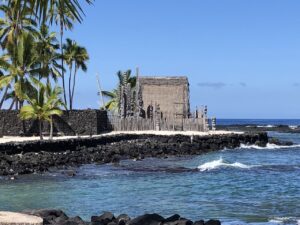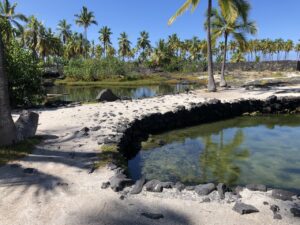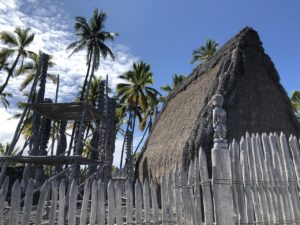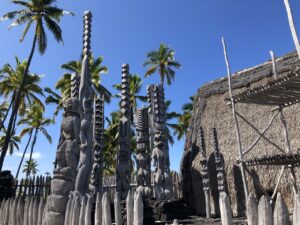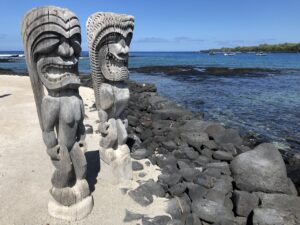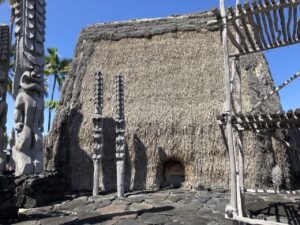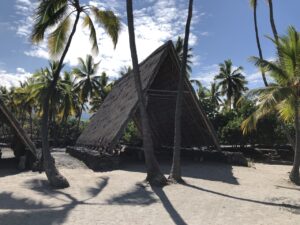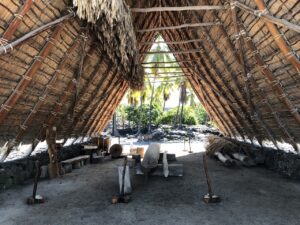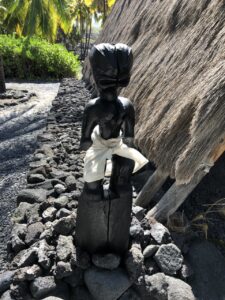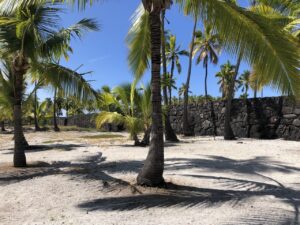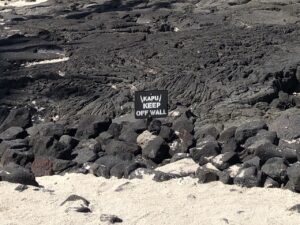In ancient Hawaii, there was a strict system of laws known as kapu that regulated many aspects of society. These rules could deal with religious practices, resource management, and behaviors relating to gender and social class. The punishment for breaking kapu could be death, unless the offender was able to flee to a sacred place of refuge, known as a pu’uhonua.
Within the borders of a pu’uhonua, a fugitive would be safe from persecution. The priest there, known as a kahuna, could perform a ceremony that would grant absolution. These sacred places could also provide refuge during wartime to the warriors of the defeated side, as well as their families. A ruling chief could designate a site as a pu’uhonua and it would remain so provided the chief stayed in power.
Today, the best preserved of these refuges is Pu’uhonua o Hōnaunau. While its exact founding is unclear, the current consensus is that the site was likely established 450 years ago by the chief of Kona. It is a site of important cultural significance and has been part of the National Park System since 1955. Visitors have the opportunity to see various traditional structures, monumental architecture, and numerous sacred carvings. I had the pleasure of visiting one day during a trip to Hawaii.
The Pu’uhonua o Hōnaunau National Park is 420 acres in size and sits on the western coast of the Big Island, in the South Kona area. Upon arriving, I walk through the visitor center, where you can learn about the history of the site. I then emerged onto the Royal Grounds, which is where generations of high chiefs (ali’i) resided. Adjacent to that area is the pu’uhonua, itself. It’s separated from the Royal Grounds by a massive rock wall. Known as the Great Wall, it measures approx. 10 feet tall, 978 long, and 17 feet wide. The park also extends south from those areas with a trail leading to the Ki’ilea Village historic site (which, unfortunately, I didn’t have time to explore).
Within the bounds of the pu’uhonua is a reconstructed temple known as the Hale o Keawe. It consists of large thatched building surrounded by a wooden palisade, sitting on top of a stone platform. There is also a wooden tower with platforms used for offerings. Around the temple are numerous wooden carvings of gods known as ki’i. (Ki’i is the Hawaiian word for what many would identify as tiki statues).
In the traditional religion of Hawaii, there are numerous gods (known as akua). Of those, there are 4 major deities: Kāne, Kanaloa, Kū, and Lono. Many of the ki’i around Hale o Keawe depict different aspects of Lono. The two ki’i by the temple entrance and those overlooking the ocean (often portrayed as emblematic of the park) are representations of Keie and Hālō (Kāne and Kanaloa). The Nation Park Service has a map of all the ki’i and which gods they represent, along with summaries of the major gods. I encourage visitors to take a look: https://www.nps.gov/puho/learn/historyculture/kii.htm
The original Hale o Keawe structure was likely built around 1650 and stored the bones of 23 high chiefs. It was believed that the royal remains held immense spiritual power (mana) and their presence sanctified the site. However, in 1819, the king abolished the kapu system and ordered that all the temples be destroyed. Hale o Keawe was initially spared, perhaps because of its function as a royal mausoleum and its overall significance. Then, in 1829, the queen regent had the bones removed, placed in coffins, and interred in nearby caves. (The remains were eventually moved to a royal mausoleum elsewhere.) It would seem that parts of Hale o Keawe were dismantled afterwards, with the overall structure remaining but falling into disuse and disrepair. Later in the 19th century, tsunamis wiped away the remaining wooden structures and severely damaged the stone platform upon which they stood.
Thankfully, the site was brought back due to major restoration efforts in the 1960s. The stone platform was rebuilt, undoing inaccurate changes from an earlier project. Additionally, artisans with the appropriate cultural knowledge rebuilt the wooden structures and carved ki’i. Maintaining the site, including replacing the ki’i when needed, is an ongoing effort.
Today, Pu’uhonua o Hōnaunau is open to visitors as part of the National Park Service. (Be sure to check the official site for operating hours and prices.) It is a place of profound cultural heritage and functions as a religious site for Native Hawaiians, where ceremonies are still held. Exploring this sacred location, with its natural beauty and history, was truly a special opportunity.
Location
Pu’uhonua o Hōnaunau National Historical Park
Highway 160
Hōnaunau, HI 96726
Official site: https://www.nps.gov/puho/index.htm
View Sources
“Diving in Pu’uhonua o Honaunau National Historical Park.” National Park Service. October 26, 2012. https://www.nps.gov/submerged/Parks/PUHO.html.
“Ending the Kapu.” Punahou School. October 12, 2021. https://bulletin.punahou.edu/ending-the-kapu/.
Greene, Linda Wedel. A Cultural History of Three Traditional Hawaiian Sites on the West Coast of Hawai’i Island. National Park Service. September 1993. https://www.nps.gov/parkhistory/online_books/kona/history9f.htm.
“Hale o Keawe.” National Park Service. September 30, 2020. https://www.nps.gov/puho/learn/historyculture/hale-o-keawe.htm.
“Ki’i.” National Park Service. May 2, 2020. https://www.nps.gov/puho/learn/historyculture/kii.htm.
“Kū-ka-‘ilimoku.” National Park Service. https://www.nps.gov/places/ku-ka-ilimoku.htm.
National Park Service. Pu’uhonua o Hōnaunau National Historical Park Foundation Document. http://npshistory.com/publications/foundation-documents/puho-fd-overview.pdf.
“Pu’uhonua o Hōnaunau.” National Park Service. May 26, 2020. https://www.nps.gov/puho/learn/historyculture/puuhonua-o-honaunau.htm.
“Pu’uhonua o Hōnaunau National Historical Park, Island of Hawaii.” Go Hawaii. April 4, 2017. https://www.gohawaii.com/islands/hawaii-big-island/regions/kona/puuhonua-o-honaunau-national-historical-park.
Written by A. P. Sylvia

